| |
|
Radiation Monitoring System "INTER-1M".
|
The radiation portal monitor "INTER-1M" is the epitome of the latest technologies to identify radiological contamination of goods and vehicles. A distinctive feature of the "Inter-1M" is the presence of the spectrometric channel measurement. Analysis of the gamma-ray spectrum allows for the identification of detected radionuclides and implement a highly sensitive detection algorithm radiation hazardous and nuclear materials. Functional capabilities and specifications radiation monitoring system "INTER-1M" consistent with the recommendations of the IAEA TECDOC-1312 and US standard ANSI N42.38-2006.
US standard ANSI N42.38-2006 regulates the requirements for the portal monitors, which are used as detectors spectrometric inorganic scintillators. Spectrometry allows the identification of gamma-ray sources. This method provides progressive indisputably information in comparison with the conventional counting the number of pulses from conventional plastic scintillators. Processing spectrometric information to enhance the sensitivity when detecting concealed radioactive material. At the same time, a significant portion of the detected anomalies caused by radionuclides of natural origin or preparations for medical purposes. To distinguish them from manmade possible only by gamma-spectrometry. The application of this technology in radiation monitoring system "INTER-1M" provides a number of advantages. Treatment of gamma-ray spectrum can detect nuclear materials without the use of any additional neutron radiation detectors. High speed, sensitivity, and all claims related to confirmed during the State metrological certification.
Radiation control system “INTER-1M” operates fully automatically.
It does not need in control or in maintenance. There is no need of special training of operator for exploitation of system “INTER-1M”. All results of measurement, event logs and photos of in-site monitoring are entered into archive. The operator is not in position to delete these data. Besides there is available access through local network or through network of INTERNET to system on “online” mode and to archive with the aim of detailed study of registered abnormalities and carrying out environmental radiation monitoring.
New technologies and algorythms realized in apparatus and in software of “INTER” system essentially increase reliability of radiation control and optimize sfforts in fight with illicit trafficing of radiation hazards and nuclear materials.
 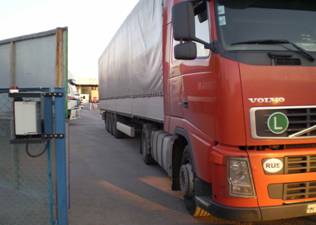
In modifications of system “INTER-1M” starting from 2014 year of manufacture it was managed to improve sensitivity due to proximity sensors up to monitoring item.
How does it operate? Being in control zone the vehicle and cargo shield radiation background. The closer cargo to detector the more pronounced effect of readings decrease.
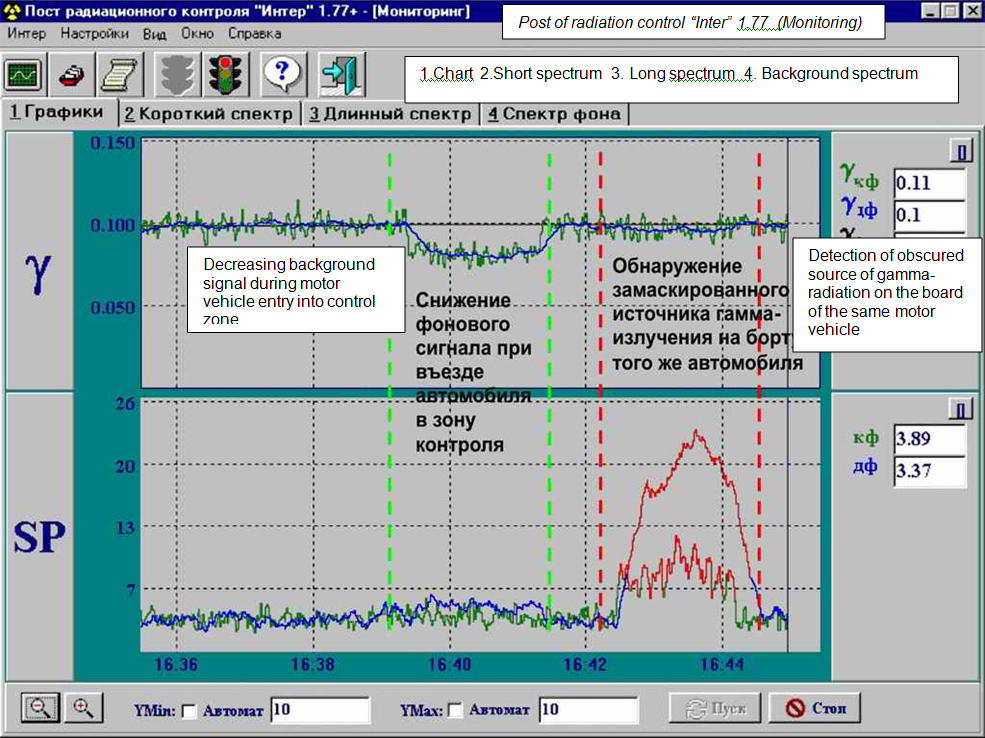
The sensor measures distance to cargo and system automatically decreasing operation threshold, increasing probability of detection of radiation contamination. This rule is valid for all algorithms , including the most effective one – analysis of spectrometric information ( see lower chart SP). With low specific activity of radionuclides in cargoes the other algorithms are not effective.
The built-in software performs the following tasks:
• adaptation to natural changes in the radiation background, automatic threshold adjustment and reduced malfunctioning;
• spectroscopy and identification of detected gamma-ray sources;
• identification of hidden radiation sources by gamma-ray spectrum distortion;
• neutron-radiation detection and recording;
• diagnostics of all components of the system;
• ability to communicate with other INTER systems over Wi-Fi and Internet to receive current and archived information, which serves as the basis for carrying out environmental radiation monitoring.
Composition of the basic hardware of the radiation control system “INTER-1M” includes the following :
Block of detecting neutron and gamma radiation, proximity detector, measuring block with hardware, monitor, IP-chamber, equipment for connection to local network, outdoor alarm, standby power system.
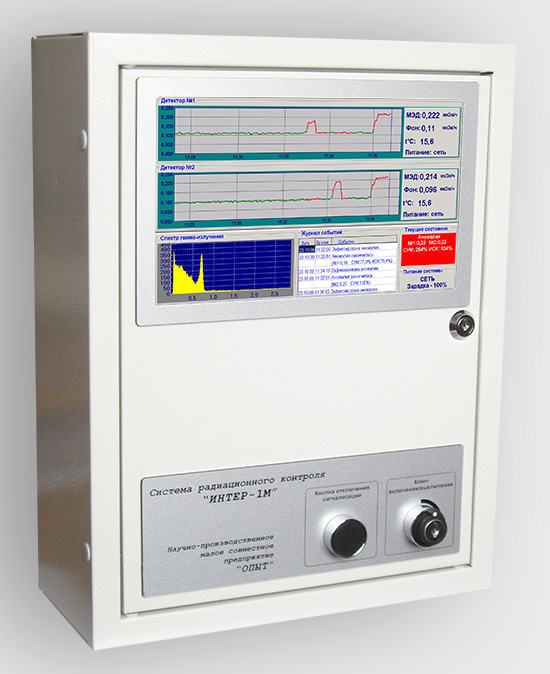
The display in a comfortable and clear view represents a lot of useful information, such as (“animated”)real time-variable MED charts and gamma-ray spectrum, update event log, information about registered anomalies, resource of self-contained power.

In cases, when between units of detecting and measuring unit are large distances, or it is incumbent to lay cables there is provided possibility of data transmission on radiochannel.
Wireless (encoded, noise-proof) transmission of data from the detectors to the measuring unit over a distance of up to 1800 m, which saves the expenses of laying expensive communications.
Minimized overal dimensions and weight of detecting units enable to establish them without erection of expensive concrete structures. All works on mounting, adjustment and putting system into operation makes up as a rule 1-2 working days.
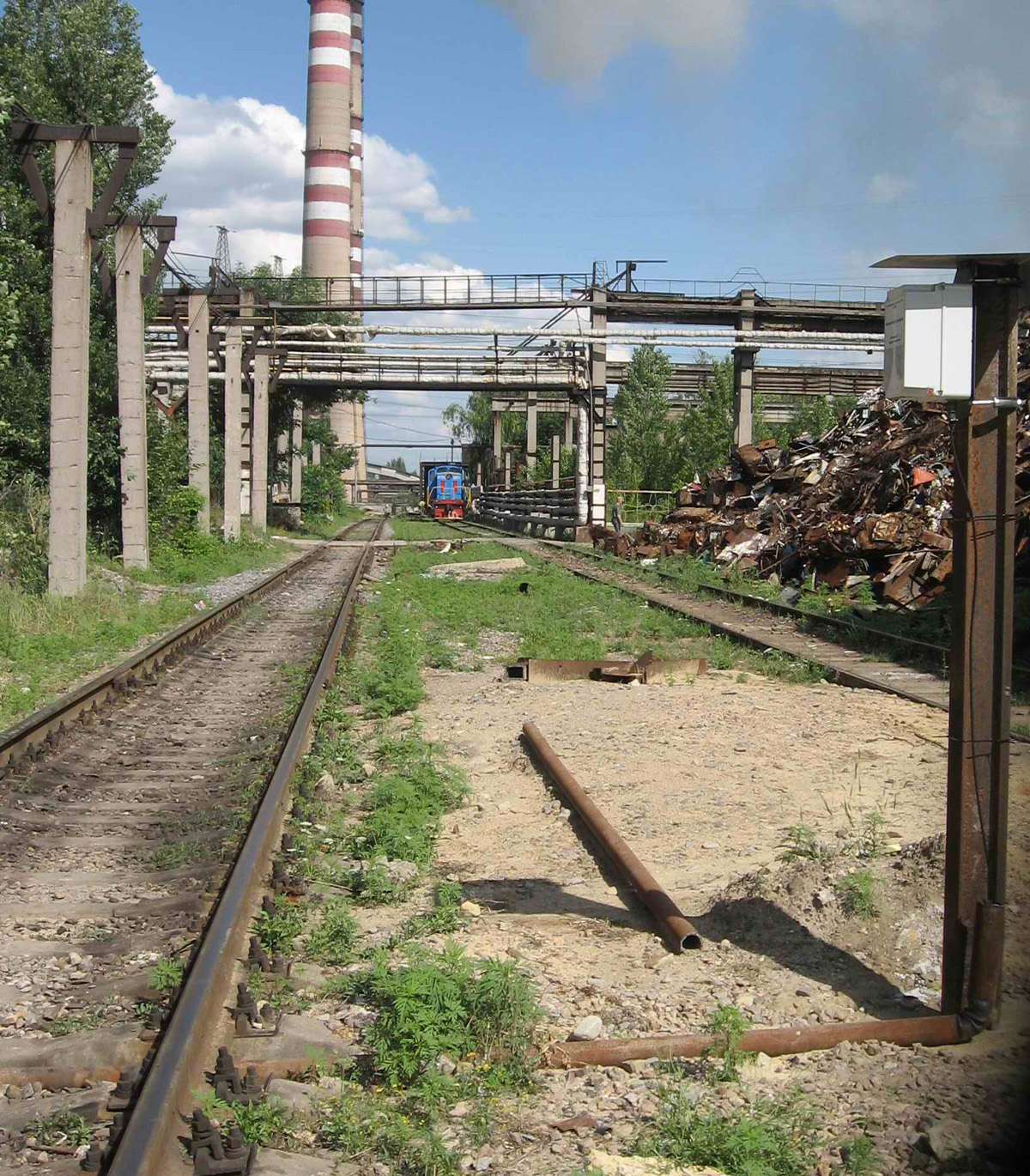
The “INTER” systems are successfully used by the enterprises of secondary metals and in ironworks for radiation monitoring of raw materials.
New, high sensitive system "INTER-1M" is installed and put into operation in 2014 for the input control of timber to the power plant on the outskirts of Ivankov, Kiev region.
 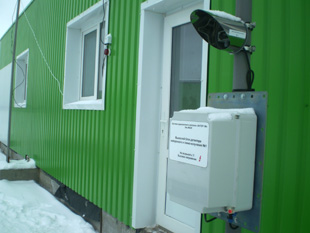
The main technical specifications.
| Gamma-ray energy range, MeV |
0,05 … 10 |
| Full width at half maximum (FWHM) for the Cs137 photopeak (depending on the volume and type of scintillator) |
from 8% to 15% |
| Working range of equivalent dose rate, µSv/h |
0,05 … 100 |
| Maximum permissible relative error of the equivalent dose rate of gamma radiation in the air with energy 1.25 MeV at P = 0.95 |
± 15% |
| Energy range of neutron radiation |
from thermal to 10 MeV |
| The range of measurements of neutron radiation flux density, sec-1·cm-2 |
0,05 … 200 |
| Energy dependence of the measured dose rate of gamma radiation in the energy range from 0.05 to 3 MeV, no more |
± 15% |
| The sensitivity of the detection unit of gamma radiation to the radiation of the radionuclide, which is located in a fixed position in the direction perpendicular to the front surface of the detection unit, sec-1/µSv/h (for Cs137) |
5000 … 20000 |
| Detection threshold of plutonium-beryllium source having an output of neutron radiation, neutron/sec |
10000 - 50000 |
| Operation mode setup time of the system, minutes, no more |
10 |
| The range of measurement time equivalent dose of gamma radiation and neutron flux, sec |
1…3 |
| The vehicle speed which is controlled |
to 10 km/h |
| False alarm rate for 24 hours of continuous operation, no more |
1 |
| Enclosure protection detection unit according to IEC 60529 |
IP56 |
| Operating temperature range for the detection unit |
from -40 to +50°C |
| Height of the control zone, m |
from 2 to 4 |
| Width of the control zone, m |
from 3 to 6 |
| Voltage AC supply |
from 150 to 240 V (50 ± 1) Hz |
Consumption 220V power up to:
Measurement unit
Backup power system with battery charge |
15 W
50 W
|
| Continuous operating time of backup power system, at least |
1,5…4 hours |
|
 |
|
|

|
03680, Ukraine, Kyiv, Palladina Avenue, 34a.
|
|
|
 |
| Director: |
Mr Igor A. Makhnyov |
|
|
|

